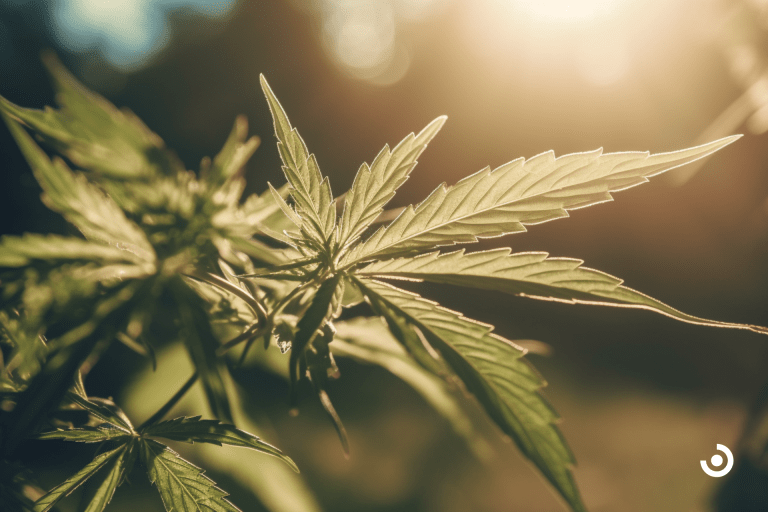Understanding Cannabis Strain Genetics: Indica vs. Sativa vs. Hybrid
by Haley Mills · June 27, 2023
Explore the differences between indica, sativa, and hybrid cannabis strains and how they can be used for treatment. Learn about the unique properties of each strain and their effects on the body.

Cannabis has been an enigmatic plant, a topic of fascination and intrigue for centuries. Its complex genetic makeup has led to a plethora of strains boasting distinct profiles, flavors, and effects. As the world begins to embrace the therapeutic potential of medical marijuana, it’s more important than ever to explore the heart of this botanical labyrinth.
In this article, we’ll embark on a journey to understand better the genetics of cannabis strains: Indica, Sativa, and Hybrid. By decoding the nuances that set them apart, we’ll unravel the mysteries of cannabis and shed light on its potential applications in medical marijuana.
The Complex World of Cannabis Genetics
Cannabis, a plant species that has captured the attention of civilizations throughout history, boasts a complex genetic landscape. Its rich genetic diversity has given rise to countless strains with unique characteristics and properties. Within the Cannabis genus are two primary species: Cannabis sativa and Cannabis indica.
Understanding the differences between these species is crucial to appreciate the vast range of cannabis strains available today. However, the genetic story does not end there, as modern breeders have developed hybrid strains that combine the traits of both Indica and Sativa plants. As a result, the genetic makeup of each strain impacts its growth patterns, appearance, and effects it imparts on the consumer.
Decoding the Indica Strain: Origins and Characteristics
The Indica strain is rooted in the Hindu Kush mountain range, which spans Afghanistan, Pakistan, and parts of India. These plants have evolved to survive in harsher climates, resulting in distinct traits.
The genetics of Indica strains confer them with the following characteristics:
- Compact and bushy plants: Indica plants are generally shorter and bushier than Sativa plants, with wider leaves. This growth pattern enables them to conserve water and energy, providing resilience in rugged environments.
- Rapid flowering: Indica strains tend to have a shorter flowering time than Sativa strains, often completing their life cycle in as little as eight weeks. This accelerated growth rate adapts to the shorter growing seasons in their native habitats.
- High resin production: Indica plants typically produce more resin, a protective barrier against the elements. This trait has also made Indica strains a popular choice for hash production.
- Effects and therapeutic potential: Indica strains are known for their relaxing, sedating effects, which can help alleviate stress, anxiety, and insomnia. These strains often exhibit potent pain-relief properties and can benefit patients seeking relief from chronic pain or muscle spasms.
Sativa Strains: Energizing and Uplifting
Cannabis sativa, the counterpart to Indica weed strains, hails from equatorial regions such as Southeast Asia, Africa, and Central and South America. These plants have adapted to thrive in warmer, sunnier climates, resulting in unique genetic traits.
Sativa strains possess the following characteristics:
- Tall and slender plants: Sativa plants tend to be taller, more slender, and elongated than Indica plants. They can reach heights of up to 20 feet, with long, narrow leaves.
- Longer flowering time: Sativa strains generally require a more extended flowering period, ranging from 10 to 16 weeks. This longer life cycle results from the abundant sunlight and lengthier growing seasons in their native habitats.
- Lower resin production: Sativa plants typically produce less resin than Indica plants, as they experience less environmental stress due to their native warmer climates.
- Effects and therapeutic potential: Sativa strains are known for their uplifting cerebral effects, which can help boost creativity, motivation, and focus. They often alleviate depression, fatigue, and mood disorders, providing an energizing experience for the consumer.
Hybrid Varieties: Blending the Best of Both Worlds
Hybrid cannabis strains result from careful crossbreeding between Indica and Sativa cannabis plants, merging the unique genetic traits of both species to create a more balanced, versatile experience. By combining the characteristics of Indica and Sativa strains, breeders can develop hybrids with specific effects and attributes tailored to meet diverse consumer needs.
Hybrid strains can be classified into three primary categories:
- Indica-dominant hybrids: These hybrids lean more towards the Indica side of the spectrum, featuring the relaxing, body-centered effects of Indica strains. They are ideal for patients seeking pain relief, relaxation, and help with sleep disorders.
- Sativa-dominant hybrids: Sativa-dominant hybrids combine Sativa strains’ uplifting, energizing effects with a touch of Indica genetics to provide a well-rounded experience. They can help combat fatigue and mood disorders and enhance focus while providing mild relaxation.
- Balanced hybrids: A perfect equilibrium of Indica and Sativa genetics, balanced hybrids offer the best of both worlds. They can deliver a harmonious blend of cerebral stimulation and physical relaxation, making them suitable for various therapeutic applications.
A hybrid strain showcases the versatility of cannabis genetics, allowing breeders to fine-tune strains for specific purposes and empowering consumers with diverse options to suit their needs.
Terpenes: The Aromatic Architects of Cannabis Experience
Terpenes, the organic compounds responsible for the distinct aromas and flavors of cannabis, play a crucial role in defining each strain’s unique profile. Over 200 terpenes have been identified in the cannabis plant, and their presence can influence the overall effects of a strain. Terpenes are not exclusive to cannabis; they can also be found in various plants and fruits.
Some of the most common terpenes in cannabis strains include:
- Myrcene: Often found in mangoes, lemongrass, and hops, myrcene is known for its earthy, musky aroma. It is believed to have sedative and anti-inflammatory properties.
- Limonene: Recognized for its citrusy scent, limonene is common in citrus fruits and is thought to have mood-enhancing, stress-relieving, and antibacterial effects.
- Linalool: In lavender, linalool boasts a floral aroma associated with calming, anti-anxiety, and pain-relief properties.
- Pinene: Found in pine needles, basil, and rosemary, pinene has a distinct pine-like scent and is believed to have anti-inflammatory, bronchodilatory, and memory-enhancing effects.
Terpenes contribute to the entourage effect, a phenomenon wherein the various compounds in cannabis work synergistically to enhance the overall therapeutic benefits of the plant. Understanding the terpene profiles of different strains can help consumers and patients make informed decisions about their cannabis choices.
Cannabinoids: The Dynamic Duo of THC and CBD
Cannabinoids are the chemical compounds found in cannabis plants that interact with receptors in the human body’s endocannabinoid system, producing various effects. There are over 100 known cannabinoids, but the two most prominent and well-studied are THC (tetrahydrocannabinol) and CBD (cannabidiol). The unique ratios of these compounds in each cannabis strain contribute to its overall effects and therapeutic potential.
- THC is a psychoactive compound responsible for the “high” associated with cannabis consumption. THC can relieve pain, stimulate appetite, and reduce nausea, benefitting patients with various medical conditions.
- CBD is non-psychoactive and does not induce a high. Its potential therapeutic benefits have gained popularity, including anti-inflammatory, anti-anxiety, and neuroprotective properties.
Strain Selection: Matching Effects to Patient Needs
With the vast array of cannabis strains available, selecting the appropriate one for a specific need can be daunting. By understanding the genetic traits, terpene profiles, and cannabinoid ratios of different strains, patients can make more informed decisions. When choosing a strain, consider the following factors and consult with medical professionals, budtenders, or experienced users who can provide valuable guidance in strain selection.
Desired effects: Determine whether you seek the energizing effects of Sativa strains, the relaxing properties of Indica strains, or a balance between the two found in hybrid strains.
Medical conditions: Identify strains with the appropriate cannabinoid content and terpene profiles to address specific health concerns, such as pain, anxiety, or sleep disorders.
Tolerance and experience: Consider your experience with cannabis and your tolerance to THC when selecting a strain, as strains with higher THC levels may be overwhelming for some users.
The Role of Genotype and Phenotype in Marijuana Strains
The genotype and phenotype of a cannabis plant are critical factors that determine its unique characteristics. The genotype refers to the plant’s genetic makeup, including the combination of genes inherited from its parent plants. The phenotype, on the other hand, is the plant’s observable physical and chemical traits, resulting from the interaction between its genotype and the environment in which it grows.
Genotype: The genetic blueprint of a cannabis plant, including traits such as cannabinoid content, terpene profiles, and growth patterns, is determined by its genotype. Crossbreeding plants with different genotypes can produce offspring with new, desirable traits.
Phenotype: The phenotype is influenced by both the genotype and environmental factors such as light, temperature, and nutrients. If grown under different conditions, two plants with the same genotype may exhibit different phenotypes.
Landrace Strains: The Purebred Ancestors of Modern Cannabis
Landrace strains hold a special place in the world of cannabis, as they represent the purebred, naturally occurring ancestors of modern cannabis varieties. These strains have evolved in isolation over thousands of years, adapting to their specific geographical regions and developing unique genetic profiles.
Landrace strains are a vital genetic reservoir, providing breeders with the foundational building blocks for creating new, diverse strains. While landrace strains may not possess the same potency or tailored effects as their modern counterparts, they carry historical and genetic significance, helping us understand the origins and evolution of the cannabis plant.
Cultivars and Crossbreeding: Crafting the Perfect Strain
Cultivars, or cultivated varieties of cannabis, have been developed through the meticulous process of crossbreeding plants with desirable traits. Breeders can create offspring of new strains with these traits by selectively breeding parent plants with specific characteristics or using female-only seeds with desired traits, such as potency, flavor, or growth patterns.
Crossbreeding different cannabis strains has given rise to many cultivars, each designed to cater to different consumer preferences and medical needs. As the cannabis industry evolves and expands, the art of crossbreeding continues to advance, allowing for the development of increasingly refined and tailored strains that address a wide range of requirements. It’s possible that the best cannabis strain has yet to be created!
The Future of Cannabis: Genetic Engineering and Custom Strains
As our understanding of cannabis genetics deepens, the potential for genetic engineering and creating custom strains becomes increasingly feasible. With advances in biotechnology and genomics, researchers can identify and manipulate specific genes responsible for traits such as cannabinoid content, terpene profiles, and resistance to pests or diseases. This level of precision and control could revolutionize the cannabis industry, enabling the development of a marijuana strain with unparalleled specificity and effectiveness for various medical conditions.
Furthermore, genetic engineering may pave the way for more sustainable and environmentally friendly cultivation practices, enhancing the overall efficiency and viability of the cannabis industry. As science and technology continue to advance, the future of cannabis promises to be one of innovation, personalization, and boundless potential for medical and recreational purposes.
Environmental Factors: How Growing Conditions Shape Cannabis Genetics
I. The Role of Climate
A. Temperature and humidity fluctuations
B. Light intensity and duration
C. Impact on growth, flowering, and yield
II. Nutrient Management
A. Balancing macronutrients and micronutrients
B. Soil composition and pH levels
C. Effects on plant health and chemical profile
III. Cultivation Techniques
A. Indoor vs. outdoor growing
B. Hydroponics, aeroponics, and soil-based systems
C. Training and pruning techniques
Cannabis Strain Potency: Debunking Myths and Misconceptions
Myth 1: Higher THC content always means a more potent high. Fact: The overall potency of a strain is influenced by a combination of factors, including the entourage effect, which involves the synergistic interaction of cannabinoids, terpenes, and other compounds.
Myth 2: Sativa strains are always more potent than Indica strains. Fact: The potency of a strain is determined by its unique genetic makeup and growing conditions, not solely by its classification as Indica or Sativa.
Myth 3: CBD counteracts the effects of THC. Fact: While CBD can modulate the effects of THC, it does not necessarily negate them. The interaction between these two cannabinoids is complex and can vary depending on the ratio of THC to CBD and individual tolerance levels.
The Science of Cannabis: Advancing Research and Understanding
- The Endocannabinoid System: Unraveling the intricate network of receptors, enzymes, and endogenous cannabinoids that play a crucial role in maintaining homeostasis in the human body.
- Emerging Cannabinoids: Exploring lesser-known cannabinoids, such as CBG, CBN, and THCV, and their potential therapeutic applications.
- Personalized Medicine: Harnessing the power of cannabis genetics and individual patient profiles to develop tailored treatment plans for various medical conditions.
- Clinical Trials and Research: Conducting rigorous, controlled studies to evaluate the safety and efficacy of cannabis as a treatment option for conditions such as epilepsy, chronic pain, and PTSD.
- Public Policy and Regulation: Navigating the evolving legal landscape of cannabis and advocating for evidence-based policy decisions to support research and patient access.
Implications & Next Steps: Understanding MMJ
As our understanding of cannabis strain genetics continues to expand, the implications for medical marijuana become increasingly profound. By dissecting the differences between Indica, Sativa, and Hybrid strains, we open doors to new therapeutic possibilities and cultivate a more personalized approach to treatment. Through this knowledge, the medical community can better harness the power of cannabis, providing targeted relief to needy patients.
Our next steps for understanding MMJ involve ongoing research, genetic profiling, and patient feedback, ultimately paving the way for breakthroughs in medicinal cannabis. As we continue to explore this enigmatic plant, we embrace a brighter future in which the true potential of medical cannabis is finally realized.
Last Updated: August 8, 2024
Get Approved for Your Medical Marijuana Card in Minutes!

Get Your Medical Card
Connect with a licensed physician online in minutes

Like This Article?
Share with your friends
Table of Contents
Keep Reading
-
The Best Method For Making CBD Oil
Unlock the Secrets of Crafting Top-Quality CBD Oil – Click Now!
-
Enhancing Meditation With Cannabis
Unleash the Power of Cannabis in Meditation: Unlock Deeper Relaxation and Mindfulness. Enhance your practice today and elevate your journey to tranquility with cannabis-infused meditation techniques. Click here to explore the ultimate guide!
-
How To Get A Medical Marijuanas Card
Unlock the Benefits of Alternative Medicine – Discover How to Get a Medical Marijuana Card Today! Take the First Step Towards Relief and Learn How to Easily Obtain Your Card Here.



